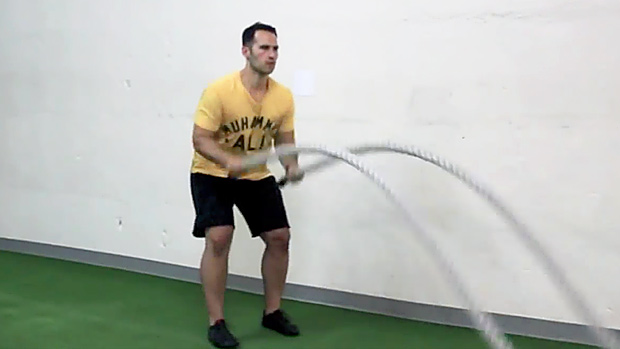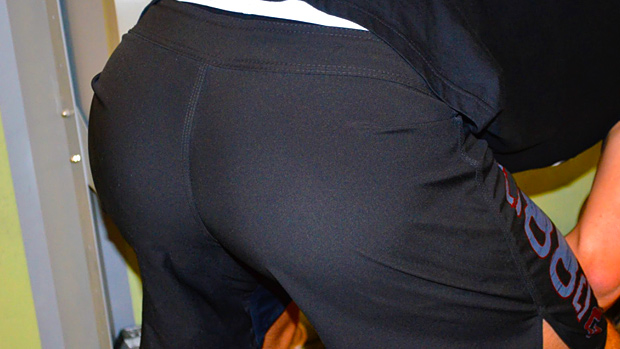Training the muscles that act on the shoulder blades – the scapular muscles – is essential for physique development and shoulder health. But many lifters don't train this area well.
Luckily, there's a way to fix this: post-exhaustion shrugs. It's the key to full upper-back development.
There's more to it than typical shrugs. I'm referring to shrugs in the broadest sense, as coined by powerlifting analyst Paul Kelso. If you're a seasoned lifter, you've probably heard of the Kelso shrug.
Well, Kelso defined this lift not just as a single exercise but as a training principle based on the movements of the shoulder blades. You'll see what I mean in the videos below.
For the post-exhaustion technique, you isolate the muscles immediately after a multi-joint exercise to deplete a muscle group.
The reason your scapular muscles are inadequately trained is that they're often the last to fatigue in exercises such as presses, pulldowns, and rows. Post-exhaustion training of the scapular muscles solves this problem by isolating them. You'll stimulate them during the compound exercise, then finish them off during the isolation exercise.
It's an advanced technique. To do it, you must be able to isolate the scapula using their six primary movements: retraction, protraction, elevation, depression, downward rotation, and upward rotation.
Trainable Movements of the Scapula

- A. Retraction: driving blade back toward spine
- B. Protraction: driving blade forward around ribcage

- C. Elevation: driving blade up
- D. Depression: driving blade down

- E. Downward Rotation: spinning blade so shoulder orients downward
- F. Upward: spinning blade so shoulder orients upward
Practice these movements as part of your warm-up.
Now let's get into the post-exhaustion exercise combos for each of these. You'll see multiple variations. The general idea is to do a multi-joint exercise immediately followed by its respective scapular shrug.
1. Row to Retraction Shrug
To train the mid traps, rhomboids, and latissimus dorsi, do a set of scapula retraction immediately following a set of rows.
- Set an adjustable bench at an incline that allows full stretch of the arms at the bottom of the row.
- Work up to a weight you can row 8-12 times.
- Do your set of rows and stop 2-3 reps shy of failure.
- Now, allow the weights to hang at your side. Do retraction shrugs by squeezing your shoulder blades together. Pause momentarily at full contraction before allowing them to be pulled apart by the weight.
- Do scapula retraction shrugs until failure.
2. Dumbbell or Landmine Row to Retraction Shrug
Standing bent-over barbell rows aren't recommended for this combo. The spinal erectors (the muscles that keep your back straight) may fail before the targeted scapular muscles, requiring you to end your set early.
If you want to do this combo standing, a unilateral row is a better choice. I like the landmine version:
Landmine Row to Retraction Shrug
Just be sure to brace your non-working arm on your leg or a bench to spare the spinal erectors from early fatigue.
3. Floor Press to Protraction Shrug
- Lie on the floor in front of a rack with catches set within reach.
- Work up to a weight you can press 8-12 times.
- Do your set of floor presses and stop 2-3 reps shy of failure.
- With elbows straight, do the protraction shrug by driving the barbell as high as you can. You'll feel the movement of the blades wrapping around the ribcage.
- Return to the bottom position by allowing the bar to lower as you draw your blades back into the retracted position.
- Repeat shrugs until failure.
4. Deadlift to Elevation Shrug
- Work up to a weight you can deadlift 6-8 times. Do your set of deadlifts, but stop at the top position, leaving 2-3 reps in reserve.
- Immediately begin your traditional barbell shrugs. Elevate your shoulders as high as you can with a momentary pause at the top.
- Shrug until failure.
We've made it to the "typical" shrug, which trains upper traps and levator scapula. Use straps so you're not limited by your grip.
Note the lower recommended number of reps for the deadlift set. Deadlifts with moderate-to-light weights performed close to failure create high amounts of systemic fatigue, which can shortchange the post-exhaustion set of shrugs.
5. Dip to Depression Shrug
- Grab a dip belt and work up to a weight that you can dip 8-12 times.
- Do traditional dips but stop 2-3 reps shy of failure.
- Immediately after, keep your elbows straight, get your body upright, and allow your torso to lower toward the ground.
- Return to the top position by driving the top of your head toward the ceiling. You'll be driving your shoulder blades down your back.
- Repeat until failure.
Depression is the opposite of a traditional shrug; it's the "anti-shrug." It describes the downward movement of the blades. Depression shrugs are a shoulder-friendly way to train the elusive lower trapezius, as well as pectoralis minor and latissimus dorsi.
6. Pulldown or Pull-Up to Downward Rotation Shrug
- For the pulldown, pick a weight you can do for 8-12 reps but stop 2-3 reps shy of failure.
- Immediately after the last pulldown, allow your arms and scapula to be drawn upward.
- Focus on pulling the bottom corners of the blades out of your armpits as if you were initiating another pulldown rep. Squeeze "down and in" at the bottom position momentarily, then allow your blades to be pulled back into upward rotation.
- Repeat until failure.
This combo hits the muscles of scapula downward rotation. Those include the rhomboids, pec minor, levator scapula, and lats.
Alternatively, you can do the same downward rotation shrug after pull-ups:
Pull-Up to Downward Rotation Shrug
The same cues apply. Use a band to assist your pull-ups if you're not as strong. Add a weighted belt if you're very strong.
7. Landmine Half-Kneeling Press to Upward Rotation Shrug
- Kneel on your working side knee with a folded towel or pad below it.
- Pick a weight you can landmine press 8-12 times, but stop 2-3 reps shy of failure.
- After the final press, without lowering the weight, do the upward rotation shrug by first allowing the shoulder blade to downwardly rotate to the bottom position while keeping the elbow straight.
- Reverse the movement as you raise the bar by "reaching" into the room. This will draw the bottom corner of your shoulder blade closer to your armpit.
- Allow your shoulder blade to settle back to the bottom position.
- Repeat upward rotation shrugs until failure.
Upward rotation of the scapula gets tons of attention in sports medicine and performance because it's essential for healthy overhead lifting mechanics. Upward rotation shrugs hit the serratus anterior, upper traps, and lower traps.
A resistance band can be added to enhance the resistance at the top of the press and enhance the resistance to upward rotation shrugs. There's a lot you can do, so check out the band setup and the resistance curve using the landmine.
It's an isolation exercise after a compound exercise, and while there's value in pre-exhaustion training, post-exhaustion for the scapular muscles is better for a couple of reasons.
It allows you to reliably train these muscles to failure, enables better form during the compound movement, and likely enhances the blood flow occlusion effect on the target muscles.
Due to large muscle cross-sectional areas and favorable biomechanics, the scapular muscles are unlikely to be the first muscles to reach failure in a compound exercise. This is why we "finish them off" with the isolated, post-exhaustion set.
If we were to use pre-exhaustion, we'd have to guesstimate how many reps to leave in reserve during the initial isolation exercise and hope the target scapular muscles fail during the compound exercise.
Also, the compound exercises tend to be more technically demanding than isolated shrugs. Logically, doing the compound exercise first, when you're fresh, results in better form. Then we can burn it out with the isolated shrugs.
The compound movement stimulates blood flow to the working muscles. Then, repeated and nearly constant contractions of the scapular muscles during isolated shrugs reduce venous drainage. This blockage creates a local chemical environment conducive to muscle growth.
In this way, post-exhaustion training may provide the hypertrophy benefits of blood-flow restriction training – without additional equipment (straps or occlusion cuffs) and without forfeiting heavy weights.
- Kelso P. Kelso's Shrug Book. Hats Off Books: Tucson, AZ. 2002.





